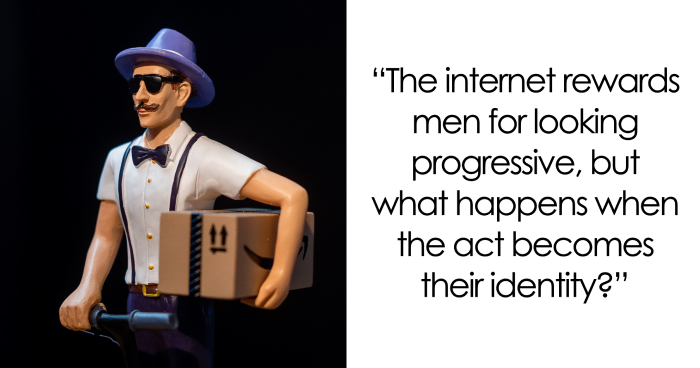Scroll through your feed and you’ll probably spot him. He’s stretched out in the park on a sunny day, tote bag slung over one shoulder, an upside-down copy of “Ain’t I a Woman?” by Bell Hooks in hand. His other hand grips an iced matcha latte. The moment seems effortless, but it’s staged with care. This is the era of the performative male.
This social media-made persona has become a viral staple in 2025. TikToks and memes revolve around this character, the guy who tries a little too hard to prove he’s progressive. He blasts Clairo, threads labubus through his belt loops, and name-drops gender theory. It might look like a running joke, but it reflects something more unsettling about identity today. In a world designed for broadcasting curated lives, performance has become a new way to measure masculinity. As men compete for attention, approval, and clout, the question shifts: who gains from the performance, and what’s the cost of keeping it up?
Welcome to the Viral Male Olympics: Flexing for Likes, Clout, and Chaos
To the chronically online or casual observer, the performative male trend has made the rounds as an endless contest for attention to find the most viral male. The games play out in multiple ways, each with its own rules and aesthetics. But before performative males became popular, we had the hypermasculine man as a major contender. Men showed off gym selfies, grueling workout routines, and chiseled bodies. As TIME notes, some fitness influencers even framed extreme training, which could cause injuries, as being tough like a real man, reinforcing the belief of “no pain, no gain.” They pushed physical discipline and self-control as the determinants of masculine worth, believing it would boost testosterone and make them more attractive to women. Unfortunately, as a 2024 study in Sage Journals found, repeatedly consuming this kind of content actually led to increased body dissatisfaction in men.
In recent times, the performative “soft boy” aesthetic has run parallel to the hypermasculine man. This archetype rejects macho displays in favor of curated sensitivity. Vox lists some of their cultural markers: tote bags, matcha lattes, feminist books, and indie music. These traits signal the performative male’s progressiveness, often to attract women by showing them he’s not like other guys. Some lean into parody, exaggerating the look to make fun of themselves, while others make a genuine attempt. Either way, the goal remains the same: appeal to the female gaze and gain clout. Social media algorithms amplify this contest, rewarding content that provokes strong reactions. The more extreme the performance, whether hyper-masculine or hyper-sensitive, the more likely it is to go viral.
This online trend has spilled over into the real world, with actual “performative male contests.” According to The Hill, these lookalike contests have been held on college campuses from Seattle to Chicago, where men deliver feminist monologues with props like rare vinyl records and painted nails. Though these contests are tongue-in-cheek, a real-life spillover of the online trend shows just how mainstream the meme has become. One contest was even described as a “straight men drag show,” highlighting how performative males act out a specific feminine-adjacent identity. While winners might get a matcha gift card or a hug from a woman, the actual prize is fleeting online fame, measured in likes, shares, and online validation.
From Alpha Self-Parody to the ‘Sigma Face’ Hall of Fame
Before the matcha-toting soft boy arrived, online masculinity was defined by other archetypes that turned into meme gold. Forbes notes that the alpha, beta, and sigma labels once formed a pseudo-hierarchy of how men presented themselves.
These categories, loosely based on animal behavior, formed a simple pecking order: alpha as the dominant leader, beta as the obedient follower, and sigma as the aloof outsider.
The self-proclaimed alpha male is often polarizing. Influencers such as Andrew Tate have built personal brands around this macho persona, encouraging others to do the same. However, many who label themselves alpha end up as the punchline, since true leaders rarely need to declare their status.

Image credits: r/memes
Beneath the humor, these roles carry troubling themes. A 2025 University of Montréal study found that sigma-related content on TikTok often blurs the line between self-help and misogyny, portraying women as distractions and emotional detachment as power. France 24 similarly reported that alpha male influencers push a superiority narrative that reinforces gender inequality. The performative male is just the latest in a long string of masculinity templates. But unlike the alphas and sigmas who perform for male approval, this version aims to appeal to women by performing progressiveness.
When Performance Turns to Parody… and Back Again
As with other masculinity shows, the general response to these performative males, who seem painfully unaware of how the behavior comes across, has been a mix of amusement and cringe. A young man reading feminist books on an escalator in a dramatically relaxed pose is cute for the first couple of videos, but when it’s the tenth reel showing off his collection of labubus, the law of diminishing returns starts to set in.
What’s Really Driving Viral Male Theater
Performative masculinity runs on a mix of social pressure, insecurity, and social media algorithms. Vox calls it part of a masculinity crisis, driven by the collapse of traditional male roles.
As gender norms shift, many young men feel unsure of how to express themselves. Some turn to social media personas in search of identity and validation. But the platforms don’t just display these performances; they shape them. Algorithms reward engagement, so content that sparks strong reactions, whether positive or negative, is pushed to the top. A 2024 University of Kent study found that TikTok and similar apps guide users toward more extreme content. This creates a loop that encourages exaggeration. Even sincere behavior can evolve into performance if that’s what earns views. These rewards are both social and biological. Stanford Medicine explains that likes and shares trigger the release of dopamine. That makes the attention addictive. At the same time, constant comparison to curated lives increases stress and dissatisfaction. For those adopting these personas, the gap between their online image and real identity can lead to anxiety, low self-worth, and disconnection. The pressure to perform delays personal growth and undermines authenticity. This impact isn’t limited to individuals. Groups made up of performative personalities struggle to build trust or community. The American Survey Center found that men already check in with friends less often than women. In this climate, even a basic connection becomes harder to form.
Off-Screen Fallout
The effects of pretending to be someone else online don’t stop when the screen turns off. They spill into real life, disrupting friendships, dating, and mental health. Constant performance weakens the ability to form meaningful, lasting connections.
When men posture as progressive solely to attract women, it becomes harder for partners to tell sincerity from strategy. On the surface, this trend appears to promote traits once dismissed as unmasculine. In reality, it introduces a new kind of dating confusion. Social media also offers a low-effort substitute for real friendships. An Interpersona study found that online friendships require less vulnerability. Because these spaces are easier to control, performative behavior thrives. But over time, this can stunt emotional closeness, leaving bonds that feel hollow once the trend fades. The mental impact is steep. Psychiatry Times reports that excessive use is tied to depression and anxiety. Even lighthearted posts can leave behind a permanent digital footprint. Content intended as a joke may be misunderstood by employers or schools, leading to lost opportunities and lasting damage. The clout may be temporary, but the personal cost of online performance can follow someone for years.
Breaking the “Bro” Spell
Amid the cringe cycles and copycat trends, some creators and communities are working to reshape what masculinity looks like. This movement centers on “positive masculinity,” which focuses on empathy, emotional strength, and connection (per Psychology Today). Rather than prescribing new rules, it encourages men to grow emotionally and support one another without pretense.
On TikTok and other platforms, creators like Rob Kenney use channels like Dad, How Do I? to offer guidance and basic life skills to young men who lack father figures.
In mental health, Dr. Alex George and podcaster Chris Williamson openly discuss topics like anxiety and depression. They aim to reduce stigma and promote emotional awareness. Comedian Devon Palmer takes a different path, using humor to satirize male archetypes.
Instagram personalities such as Olly Bowman also challenge the polished image culture. By encouraging followers to embrace awkwardness and be seen trying, he reframes vulnerability as strength.
Pop culture contributes too. Celebrities like Harry Styles, who blend masculine and feminine fashion, often face criticism. But their visibility pushes for more expansive ideas of self-expression. Even if some men begin this journey for show, it can still lead somewhere real. As Dr. Juliet Williams told the Independent, getting men “in the door is halfway to victory.” A superficial entry point can still spark genuine change. The answer to performative masculinity is not retreating to old models. It is building space for honesty, humor, and connection without forcing anyone to fit a mold.
FAQ
What does it mean when someone is being performative?
According to Merriam-Webster, a person is being performative when they’re doing something mainly to impress an audience, or when they’re acting or displaying certain behaviors for show or effect.
What does it mean that gender is performative?
Based on Judith Butler’s view of gender theory, gender doesn’t come from biology (per The Conversation). Rather, it is something performed through the ways we talk, dress, and act.









